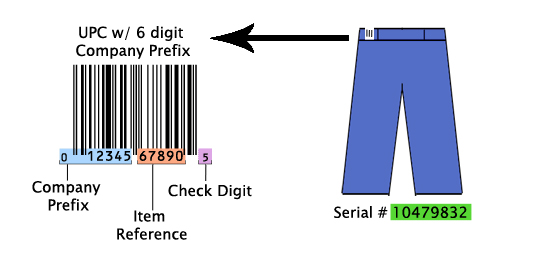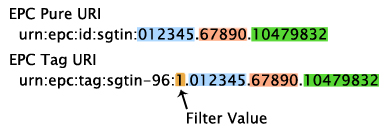What is the SGTIN-96?
SGTIN-96 is an encoding scheme that stands for Serialized Global Trade Identification Number and is sometimes called a serialized GTIN. The 96 in the name refers to the number of bits in the final EPC binary form, and there are three options - 64, 96, 198. To learn about binary form and conversion, jump to our article Encoding RFID Tags: 3 Things to Know and check out the “Conversions - Bits > Hex > ASCII” portion.
SGTIN-96 is the most popular of the 3 options because it allows for the most data without requiring a high memory RFID tag. If you do not know what an encoding scheme is, read our article GS1 Identification Schemes/Encoding Schemes and Their Uses to get up to date!
What is the SGTIN-96 Used For?
A SGTIN-96 is typically used for global trade items, and is used most frequently in the retail sector. It is used in both barcodes and RFID tags and an item is typically assigned a SGTIN-96 at the manufacturer level, and that item keeps the same SGTIN throughout the supply chain. A SGTIN is a subcategory of the broader category GTIN, which is also a very popular, general encoding scheme that is used for identifying medical devices, consumer goods, and raw materials.
The Vulcan RFID Read & Write Software can be used to verify SGTIN-96.
What Makes Up a SGTIN-96?
A SGTIN-96 is basically a standardized way to organize key identification numbers into one string of data, and can be used with barcodes or RFID tags. As you can see in the image below, “01234567890” is the UPC which is also known as a GTIN(-12). The “5” at the end is a calculated check digit that does not make up part of the UPC/GTIN.

Those 12 numbers, in addition to the serial number under the pair of pants on the right, together form the SGTIN. Once the full number comes together it is “0123456789010479832”, which would be difficult to understand or make use of unless you knew how to read it.

When the SGTIN is deconstructed, it contains the Company Prefix, Item Reference, and Serial Number. When you are using SGTIN-96 with a barcode, it will also include a check digit. If you are using the SGTIN-96 with RFID Tags, it will also contain the Filter Value. If your RFID reader and/or barcode scanner has been set to decode SGTIN-96, immediately upon reading/scanning the item, the reader/scanner should easily separate the meaningful data.
Where Can I Learn More About the SGTIN-96?
GS1 has some great information and tutorials to help you learn about the SGTIN-96 and even create your own SGTIN-96 from a UPC number.
How to Translate a UPC to a GTIN to a SGTIN to an EPC:
https://www.gs1us.org/DesktopModules/Bring2mind/DMX/Download.aspx?Command=Core_Download&EntryId=389
Encode or Decode an EPC Number:
https://www.gs1us.org/tools/epc-encoder-decoder
Check Digit Calculator (for Barcodes):
https://www.gs1us.org/tools/check-digit-calculator
GS1 Company Database:
https://www.gs1us.org/tools/gs1-company-database-gepir
RFID Serialization Management for SGTIN-96:
https://www.gs1us.org/DesktopModules/Bring2mind/DMX/Download.aspx?Command=Core_Download&EntryId=684
Conclusion
For more information on the SGTIN-96 – or anything related to RFID and IoT, comment below or contact us! For more information about RFID Tag Mandates for Suppliers, check out our Walmart and Nordstrom & Macy's articles – or contact us!
